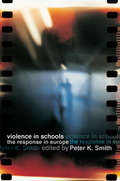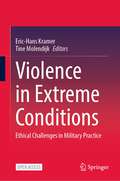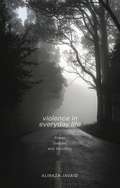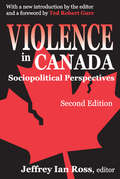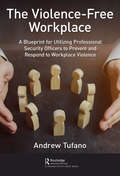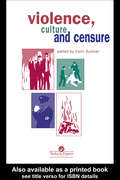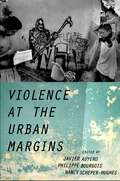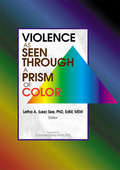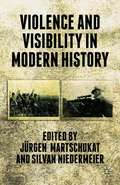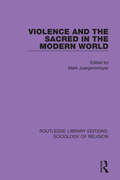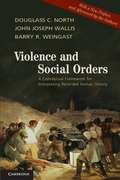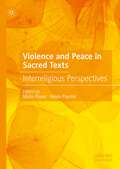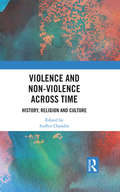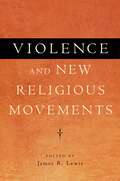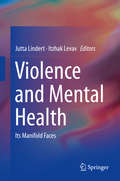- Table View
- List View
Violence in Schools: The Response in Europe
by Peter K. SmithViolence in schools is a pervasive, highly emotive and, above all, global problem. Bullying and its negative social consequences are of perennial concern, while the media regularly highlights incidences of violent assault - and even murder - occurring within schools. This unique and fascinating text offers a comprehensive overview and analysis of how European nations are tackling this serious issue.Violence in Schools: The Response in Europe, brings together contributions from all EU member states and two associated states. Each chapter begins by clearly outlining the nature of the school violence situation in that country. It then goes on to describe those social policy initiatives and methods of intervention being used to address violence in schools and evaluates the effectiveness of these different strategies. Commentaries from Australia, Israel and the USA and an overview of the book's main themes by eminent psychologist Peter K. Smith complete a truly international and authoritative look at this important - and frequently controversial - subject.This book constitutes an invaluable resource for educational administrators, policymakers and researchers concerned with investigating, and ultimately addressing, the social and psychological causes, manifestations and effects of school violence.
Violence in Schools: The Response in Europe
by Peter K. SmithViolence in schools is a pervasive, highly emotive and, above all, global problem. Bullying and its negative social consequences are of perennial concern, while the media regularly highlights incidences of violent assault - and even murder - occurring within schools. This unique and fascinating text offers a comprehensive overview and analysis of how European nations are tackling this serious issue.Violence in Schools: The Response in Europe, brings together contributions from all EU member states and two associated states. Each chapter begins by clearly outlining the nature of the school violence situation in that country. It then goes on to describe those social policy initiatives and methods of intervention being used to address violence in schools and evaluates the effectiveness of these different strategies. Commentaries from Australia, Israel and the USA and an overview of the book's main themes by eminent psychologist Peter K. Smith complete a truly international and authoritative look at this important - and frequently controversial - subject.This book constitutes an invaluable resource for educational administrators, policymakers and researchers concerned with investigating, and ultimately addressing, the social and psychological causes, manifestations and effects of school violence.
Violence in Extreme Conditions: Ethical Challenges in Military Practice
by Eric-Hans Kramer Tine MolendijkAs an organization operating under extreme conditions, the military is often confronted with destructive behavior from individuals, organizations, and societies. Written by experts from a variety of disciplines, this open access book reflects on confrontations with violence under extreme conditions and the various challenges that arise.By examining real first-hand accounts of soldiers’ deployments, the contributions shed new light on the multifaceted and sometimes hidden dynamics of destructive violent behavior and offer an ethical reflection on military practices. In addition, they address topics such as moral decision-making in violent contexts, military trauma, organizational change, and military ethics education.The interdisciplinary exploration of these topics has been the primary focus of Désirée Verweij, who was the Chair of Military Ethics at the Netherlands Defence Academy from 2008 to 2021. The contributions in this book are written in honor of her scholarly achievements and help to ensure that these important issues continue to receive attention. The book will appeal to scholars of military studies, organizational studies and military ethics, and to professionals and decisionmakers in military organizations.
Violence in Everyday Life: Power, Gender and Sexuality
by Aliraza JavaidViolence in Everyday Life explores how identity markers such as gender and sexuality intersect with violence, synthesizing the themes of gender, sexuality and violence to offering a crucial and coherent framework for understanding the interrelationship between these concepts.Aliraza Javaid explores how violence is experienced at a local, regional and global level, and considers the ways in which hegemonic masculinities are reproduced through violence. Attention is given to the particular ways in which these constructions of masculinity are reflected in areas such as homophobic violence, transphobic violence, and violence against intimate partners. Drawing on new empirical data and his own personal experiences of violence, as well as identifying new areas for further research, Javaid's work represents a unique study of the interconnectedness of violence, gender and sexuality, and of how violence is fuelled by society's attitudes towards masculinity.
Violence in Everyday Life: Power, Gender and Sexuality
by Aliraza JavaidViolence in Everyday Life explores how identity markers such as gender and sexuality intersect with violence, synthesizing the themes of gender, sexuality and violence to offering a crucial and coherent framework for understanding the interrelationship between these concepts.Aliraza Javaid explores how violence is experienced at a local, regional and global level, and considers the ways in which hegemonic masculinities are reproduced through violence. Attention is given to the particular ways in which these constructions of masculinity are reflected in areas such as homophobic violence, transphobic violence, and violence against intimate partners. Drawing on new empirical data and his own personal experiences of violence, as well as identifying new areas for further research, Javaid's work represents a unique study of the interconnectedness of violence, gender and sexuality, and of how violence is fuelled by society's attitudes towards masculinity.
Violence in Canada: Sociopolitical Perspectives
by Jeffrey RossMany people consider Canada, particularly in comparison to its southern cousin, as a "peaceable kingdom." However, as the historical record demonstrates, Canadians have never been a thoroughly non-violent people. Violence in Canada highlights from an interdisciplinary perspective the major areas and contexts where violence takes place.Consisting of thirteen contributions, the book forms an indispensable guide to the subject. All of the authors are experts in their field, many with international reputations, and are drawn from the fields of sociology, political science, history, and criminology. The foreword by Ted Robert Gurr, author of Violence in America, is followed by an historical analysis of violence on the Canadian western frontier. Other scholars describe contemporary violence: by and against indigenous peoples, women, children, and the elderly; in labor-related disputes; homicide; police and prison violence; terrorism; and discuss government responses and policy implications. Each chapter specifically addresses the sociological and political dimensions of violence. The authors make ample use of statistics and empirical research. Jeffrey Ian Ross's introduction outlines the sociopolitical dynamics of violence, and his summary chapter offers directions for future research. When the book was first published in 1995 it was widely praised by scholarly journals and has since become a standard text in the study of violence and modern Canadian cultural studies.The book is all the more valuable as its new introduction places its findings in the context of research that has been produced since the original publication. Violence in Canada will be of interest to sociologists, criminologists, and political scientists.Jeffrey Ian Ross is an associate professor in the Division of Criminology, Criminal Justice and Social Policy and fellow with the Center for Comparative and International Law, University of Baltimore. His work has appeared in many academic journals and chapters in academic texts, as well as articles in popular magazines in Canada and the United States. He is the author, co-author, editor, or co-editor of eight books.Ted Robert Gurr is Distinguished University Professor at the University of Maryland. Among his books are Why Men Rebel and Violence in America.
Violence in Canada: Sociopolitical Perspectives
by Jeffrey RossMany people consider Canada, particularly in comparison to its southern cousin, as a "peaceable kingdom." However, as the historical record demonstrates, Canadians have never been a thoroughly non-violent people. Violence in Canada highlights from an interdisciplinary perspective the major areas and contexts where violence takes place.Consisting of thirteen contributions, the book forms an indispensable guide to the subject. All of the authors are experts in their field, many with international reputations, and are drawn from the fields of sociology, political science, history, and criminology. The foreword by Ted Robert Gurr, author of Violence in America, is followed by an historical analysis of violence on the Canadian western frontier. Other scholars describe contemporary violence: by and against indigenous peoples, women, children, and the elderly; in labor-related disputes; homicide; police and prison violence; terrorism; and discuss government responses and policy implications. Each chapter specifically addresses the sociological and political dimensions of violence. The authors make ample use of statistics and empirical research. Jeffrey Ian Ross's introduction outlines the sociopolitical dynamics of violence, and his summary chapter offers directions for future research. When the book was first published in 1995 it was widely praised by scholarly journals and has since become a standard text in the study of violence and modern Canadian cultural studies.The book is all the more valuable as its new introduction places its findings in the context of research that has been produced since the original publication. Violence in Canada will be of interest to sociologists, criminologists, and political scientists.Jeffrey Ian Ross is an associate professor in the Division of Criminology, Criminal Justice and Social Policy and fellow with the Center for Comparative and International Law, University of Baltimore. His work has appeared in many academic journals and chapters in academic texts, as well as articles in popular magazines in Canada and the United States. He is the author, co-author, editor, or co-editor of eight books.Ted Robert Gurr is Distinguished University Professor at the University of Maryland. Among his books are Why Men Rebel and Violence in America.
The Violence-Free Workplace: A Blueprint for Utilizing Professional Security Officers to Prevent and Respond to Workplace Violence
by Andrew TufanoOrganizations are ethically, morally, and legally required to maintain safe workplaces that protects employees, visitors and anyone who frequents their establishments. But why do organizations that employee uniformed security personnel as part of their overall workplace violence prevention program still struggle to create and maintain the safest possible workplaces? To meet these obligations organizations often employ uniformed security officers to deter, observe, and report criminal behavior, and in some contexts, they physically interact with dangerous individuals to protect employees, consumers and visitors from violent behaviors. Unfortunately, many organizations don’t utilize their security personnel to their fullest potential and organizational and community members continue to be victims of workplace violence. This book identifies the flawed principles, policies and personnel decisions that organizations use, and it provides practical solutions to address them. The book covers two major themes: the misapplication of law enforcement community safety principles to private, free-market businesses and the use of risk aversive philosophies to their security officer’s activities. This book covers the principles, policies and personnel necessary for maximizing the effectiveness of uniformed security personnel to successfully mitigate potential workplace violence and create and maintain safe organizations. There is a strong need for this book since workplace violence prevention has taken on a new focus due to increases in workplace violence incidents and new laws requiring organizations to take a more serious approach to workplace violence prevention. The healthcare and campus markets are most affected by these laws and are under public scrutiny because of their vulnerable populations. These two markets combined employ the most non-contract, propriety private security personnel in the country. Both markets rely on uniform security officers to create and maintain safe communities and play an important role in their respective workplace violence prevention plans.
The Violence-Free Workplace: A Blueprint for Utilizing Professional Security Officers to Prevent and Respond to Workplace Violence
by Andrew TufanoOrganizations are ethically, morally, and legally required to maintain safe workplaces that protects employees, visitors and anyone who frequents their establishments. But why do organizations that employee uniformed security personnel as part of their overall workplace violence prevention program still struggle to create and maintain the safest possible workplaces? To meet these obligations organizations often employ uniformed security officers to deter, observe, and report criminal behavior, and in some contexts, they physically interact with dangerous individuals to protect employees, consumers and visitors from violent behaviors. Unfortunately, many organizations don’t utilize their security personnel to their fullest potential and organizational and community members continue to be victims of workplace violence. This book identifies the flawed principles, policies and personnel decisions that organizations use, and it provides practical solutions to address them. The book covers two major themes: the misapplication of law enforcement community safety principles to private, free-market businesses and the use of risk aversive philosophies to their security officer’s activities. This book covers the principles, policies and personnel necessary for maximizing the effectiveness of uniformed security personnel to successfully mitigate potential workplace violence and create and maintain safe organizations. There is a strong need for this book since workplace violence prevention has taken on a new focus due to increases in workplace violence incidents and new laws requiring organizations to take a more serious approach to workplace violence prevention. The healthcare and campus markets are most affected by these laws and are under public scrutiny because of their vulnerable populations. These two markets combined employ the most non-contract, propriety private security personnel in the country. Both markets rely on uniform security officers to create and maintain safe communities and play an important role in their respective workplace violence prevention plans.
Violence, Culture And Censure
by Professor Colin Sumner Colin SumnerEssays reflecting on our understanding and moral judgement of violence. The essays argue that even serious violence is not a simple fact, but a category of thought and practice rooted in history, culture and society.
Violence, Culture And Censure
by Professor Colin Sumner Colin SumnerEssays reflecting on our understanding and moral judgement of violence. The essays argue that even serious violence is not a simple fact, but a category of thought and practice rooted in history, culture and society.
VIOLENCE AT THE URBAN MARGINS GCE C (Global and Comparative Ethnography)
by Javier Auyero, Philippe Bourgois and Nancy Scheper-HughesIn the Americas, debates around issues of citizen's public safety--from debates that erupt after highly publicized events, such as the shootings of Jordan Davis and Trayvon Martin, to those that recurrently dominate the airwaves in Latin America--are dominated by members of the middle and upper-middle classes. However, a cursory count of the victims of urban violence in the Americas reveals that the people suffering the most from violence live, and die, at the lowest of the socio-symbolic order, at the margins of urban societies. The inhabitants of the urban margins are hardly ever heard in discussions about public safety. They live in danger but the discourse about violence and risk belongs to, is manufactured and manipulated by, others--others who are prone to view violence at the urban margins as evidence of a cultural, or racial, defect, rather than question violence's relationship to economic and political marginalization. As a result, the experience of interpersonal violence among the urban poor becomes something unspeakable, and the everyday fear and trauma lived in relegated territories is constantly muted and denied. This edited volume seeks to counteract this pernicious tendency by putting under the ethnographic microscope--and making public--the way in which violence is lived and acted upon in the urban peripheries. It features cutting-edge ethnographic research on the role of violence in the lives of the urban poor in South, Central, and North America, and sheds light on the suffering that violence produces and perpetuates, as well as the individual and collective responses that violence generates, among those living at the urban margins of the Americas.
Violence at the Urban Margins (Global and Comparative Ethnography)
by Javier Auyero Philippe Bourgois Nancy Scheper-HughesIn the Americas, debates around issues of citizen's public safety--from debates that erupt after highly publicized events, such as the shootings of Jordan Davis and Trayvon Martin, to those that recurrently dominate the airwaves in Latin America--are dominated by members of the middle and upper-middle classes. However, a cursory count of the victims of urban violence in the Americas reveals that the people suffering the most from violence live, and die, at the lowest of the socio-symbolic order, at the margins of urban societies. The inhabitants of the urban margins are hardly ever heard in discussions about public safety. They live in danger but the discourse about violence and risk belongs to, is manufactured and manipulated by, others--others who are prone to view violence at the urban margins as evidence of a cultural, or racial, defect, rather than question violence's relationship to economic and political marginalization. As a result, the experience of interpersonal violence among the urban poor becomes something unspeakable, and the everyday fear and trauma lived in relegated territories is constantly muted and denied. This edited volume seeks to counteract this pernicious tendency by putting under the ethnographic microscope--and making public--the way in which violence is lived and acted upon in the urban peripheries. It features cutting-edge ethnographic research on the role of violence in the lives of the urban poor in South, Central, and North America, and sheds light on the suffering that violence produces and perpetuates, as well as the individual and collective responses that violence generates, among those living at the urban margins of the Americas.
Violence as Seen Through a Prism of Color
by Letha A SeeSo many parts of society target citizens of color for violence--what can be done? Violence as Seen Through a Prism of Color examines violence from a structural perspective, including violence in prisons, schools and colleges, churches, homes, and within political/corporate structures.This unique, hard-hitting book argues that individual violence stems from the structure of our society and its institutions. Most of the contributors are African- American educators and practitioners who have a thorough understanding of structural violence. Some have experienced political violence; others have expert knowledge of structural violence within the criminal justice system, educational institutions, and elsewhere--even in churches and homes. Their writings are undeniably, unflinchingly authentic--it is impossible not to be moved and enraged by what they have to say. The good news is that in addition to calling attention to the structural violence in our society they provide excellent insights on how the situation might be resolved.Violence as Seen Through a Prism of Color shows: that much of the violence within the criminal justice system stems from decisions made at the highest levels of government that minority offenders are much more frequently convicted and more harshly sentenced than their white counterparts how cultural racism contributes to the construction of motives for lynching, hate crime, and police violence against Americans of color such as Abner Louima, Amadou Diallo, and Rodney King how the judicial system encourages black on black violence by neglecting to halt criminal activities in non-white neighborhoods how, in the words of Mahatma Gandhi, ”Poverty is the worst form of violence”You’ll also learn: how corporations are amassing great wealth through privatizing prisons and conscripting the labor of non-violent African-American prisoners how racial profiling affects people of color how the media has exploited black men imprisoned for minor drug offenses how and why violence occurs in and against the black churchHelpful charts and tables (like one that names the corporations that use prison labor) supplement the material--you’ll be surprised at what you learn! Extensive references are included at the end of each chapter.
Violence as Seen Through a Prism of Color
by Letha A SeeSo many parts of society target citizens of color for violence--what can be done? Violence as Seen Through a Prism of Color examines violence from a structural perspective, including violence in prisons, schools and colleges, churches, homes, and within political/corporate structures.This unique, hard-hitting book argues that individual violence stems from the structure of our society and its institutions. Most of the contributors are African- American educators and practitioners who have a thorough understanding of structural violence. Some have experienced political violence; others have expert knowledge of structural violence within the criminal justice system, educational institutions, and elsewhere--even in churches and homes. Their writings are undeniably, unflinchingly authentic--it is impossible not to be moved and enraged by what they have to say. The good news is that in addition to calling attention to the structural violence in our society they provide excellent insights on how the situation might be resolved.Violence as Seen Through a Prism of Color shows: that much of the violence within the criminal justice system stems from decisions made at the highest levels of government that minority offenders are much more frequently convicted and more harshly sentenced than their white counterparts how cultural racism contributes to the construction of motives for lynching, hate crime, and police violence against Americans of color such as Abner Louima, Amadou Diallo, and Rodney King how the judicial system encourages black on black violence by neglecting to halt criminal activities in non-white neighborhoods how, in the words of Mahatma Gandhi, ”Poverty is the worst form of violence”You’ll also learn: how corporations are amassing great wealth through privatizing prisons and conscripting the labor of non-violent African-American prisoners how racial profiling affects people of color how the media has exploited black men imprisoned for minor drug offenses how and why violence occurs in and against the black churchHelpful charts and tables (like one that names the corporations that use prison labor) supplement the material--you’ll be surprised at what you learn! Extensive references are included at the end of each chapter.
Violence and Visibility in Modern History
by JüRGEN Martschukat Silvan NiedermeierDespite the claims of Steven Pinker and others, violence has remained a historical constant since the Enlightenment, even though its forms and visibility have been radically transformed. Accordingly, the studies gathered here recast debate over violence in modern societies by undermining teleological and reassuring narratives of progress.
Violence and the Sacred in the Modern World (Routledge Library Editions: Sociology of Religion #17)
by Mark JuergensmeyerHow is symbolic violence related to the real acts of religious violence around the modern world? The authors of this book, first published in 1992, explore this question with reference to some of the most volatile religious and political conflicts of the day: Hezbollah in Lebanon, Sikhs in India, militant Jewish groups in Israel, and Muslim movements from the Middle East to Indonesia. In addition to providing valuable insights into these important incidents, the authors – social scientists and historians of comparative religion – are responding to the theoretical issues articulated by René Girard in Violence and the Sacred (1977). The present volume is the first book of essays to test Girard’s theories about the social significance of religious symbols of violence against real, rather than symbolic, acts. In some cases his theories are found to be applicable; in other cases, the authors provide alternative theories of their own. In a concluding essay, co-authored by Mark Anspach, Girard provides a response.
Violence and the Sacred in the Modern World (Routledge Library Editions: Sociology of Religion #17)
by Mark JuergensmeyerHow is symbolic violence related to the real acts of religious violence around the modern world? The authors of this book, first published in 1992, explore this question with reference to some of the most volatile religious and political conflicts of the day: Hezbollah in Lebanon, Sikhs in India, militant Jewish groups in Israel, and Muslim movements from the Middle East to Indonesia. In addition to providing valuable insights into these important incidents, the authors – social scientists and historians of comparative religion – are responding to the theoretical issues articulated by René Girard in Violence and the Sacred (1977). The present volume is the first book of essays to test Girard’s theories about the social significance of religious symbols of violence against real, rather than symbolic, acts. In some cases his theories are found to be applicable; in other cases, the authors provide alternative theories of their own. In a concluding essay, co-authored by Mark Anspach, Girard provides a response.
Violence And Social Orders (PDF)
by Douglass C. North John Joseph Wallis Barry R. WeingastAll societies must deal with the possibility of violence, and they do so in different ways. This book integrates the problem of violence into a larger social science and historical framework, showing how economic and political behavior are closely linked. Most societies, which we call natural states, limit violence by political manipulation of the economy to create privileged interests. These privileges limit the use of violence by powerful individuals, but doing so hinders both economic and political development. In contrast, modern societies create open access to economic and political organizations, fostering political and economic competition. The book provides a framework for understanding the two types of social orders, why open access societies are both politically and economically more developed, and how some 25 countries have made the transition between the two types.
Violence and Peace in Sacred Texts: Interreligious Perspectives
by Maria Power Helen PaynterThis volume brings together 11 experts from a range of religious backgrounds, to consider how each tradition has interpreted matters of violence and peace in relation to its sacred text. The traditions covered are Hinduism, Buddhism, Judaism, Christianity, Islam and Sikhism. The role of religion in conflict, war, and the creation of peaceful settlements has attracted much academic attention, including considerations of the interpretation of violence in sacred texts. This collection breaks new ground by bringing multiple faiths into conversation with one another with specific regard to the handling of violence and peace in sacred texts. This combination of close attention to text and expansive scope of religious inclusion is the first of its kind.
Violence and Non-Violence across Time: History, Religion and Culture
by Sudhir ChandraThis book probes the complex interweaving, across time and cultures, of violence and non-violence from the perspective of the present. One of the first of its kind, it offers a comprehensive examination of the interpenetration of violence and non-violence as much in human nature as in human institutions with reference to different continents, cultures and religions over centuries. It points to the present paradox that even as violence of unprecedented lethality threatens the very survival of humankind, non-violence increasingly appears as an unlikely feasible alternative. The essays presented here cover a wide cultural–temporal spectrum — from Vedic sacrifice, early Jewish–Christian polemics, the Crusades, and medieval Japan to contemporary times. They explore aspects of the violence–non-violence dialectic in a coherent frame of analysis across themes such as war, jihad, death, salvation, religious and philosophical traditions including Buddhism, Christianity, Judaism, Hinduism, Islam, mysticism, monism, and Neoplatonism, texts such as Ramayana, Mahabharata and Quran, as well as issues faced by Dalits and ethical imperatives for clinical trials, among others. Offering thematic width and analytical depth to the treatment of the subject, the contributors bring their disciplinary expertise and cultural insights, ranging from the historical to sociological, theological, philosophical and metaphysical, as well as their sensitive erudition to deepening an understanding of a grave issue. The book will be useful to scholars and researchers of history, peace and conflict studies, political science, political thought and cultural studies, as well as those working on issues of violence and non-violence.
Violence and Non-Violence across Time: History, Religion and Culture
by Sudhir ChandraThis book probes the complex interweaving, across time and cultures, of violence and non-violence from the perspective of the present. One of the first of its kind, it offers a comprehensive examination of the interpenetration of violence and non-violence as much in human nature as in human institutions with reference to different continents, cultures and religions over centuries. It points to the present paradox that even as violence of unprecedented lethality threatens the very survival of humankind, non-violence increasingly appears as an unlikely feasible alternative. The essays presented here cover a wide cultural–temporal spectrum — from Vedic sacrifice, early Jewish–Christian polemics, the Crusades, and medieval Japan to contemporary times. They explore aspects of the violence–non-violence dialectic in a coherent frame of analysis across themes such as war, jihad, death, salvation, religious and philosophical traditions including Buddhism, Christianity, Judaism, Hinduism, Islam, mysticism, monism, and Neoplatonism, texts such as Ramayana, Mahabharata and Quran, as well as issues faced by Dalits and ethical imperatives for clinical trials, among others. Offering thematic width and analytical depth to the treatment of the subject, the contributors bring their disciplinary expertise and cultural insights, ranging from the historical to sociological, theological, philosophical and metaphysical, as well as their sensitive erudition to deepening an understanding of a grave issue. The book will be useful to scholars and researchers of history, peace and conflict studies, political science, political thought and cultural studies, as well as those working on issues of violence and non-violence.
Violence and New Religious Movements
by James R. LewisThe relationship between new religious movements (NRMs) and violence has long been a topic of intense public interest--an interest heavily fueled by multiple incidents of mass violence involving certain groups. Some of these incidents have made international headlines. When New Religious Movements make the news, it's usually because of some violent episode. Some of the most famous NRMs are known much more for the violent way they came to an end than for anything else. Violence and New Religious Movements offers a comprehensive examination of violence by-and against-new religious movements. The book begins with theoretical essays on the relationship between violence and NRMs and then moves on to examine particular groups. There are essays on the "Big Five"--the most well-known cases of violent incidents involving NRMs: Jonestown, Waco, Solar Temple, the Aum Shunrikyo subway attack, and the Heaven's Gate suicides. But the book also provides a richer survey by examining a host of lesser-known groups. This volume is the culmination of decades of research by scholars of New Religious Movements.
Violence and New Religious Movements
by James R. LewisThe relationship between new religious movements (NRMs) and violence has long been a topic of intense public interest--an interest heavily fueled by multiple incidents of mass violence involving certain groups. Some of these incidents have made international headlines. When New Religious Movements make the news, it's usually because of some violent episode. Some of the most famous NRMs are known much more for the violent way they came to an end than for anything else. Violence and New Religious Movements offers a comprehensive examination of violence by-and against-new religious movements. The book begins with theoretical essays on the relationship between violence and NRMs and then moves on to examine particular groups. There are essays on the "Big Five"--the most well-known cases of violent incidents involving NRMs: Jonestown, Waco, Solar Temple, the Aum Shunrikyo subway attack, and the Heaven's Gate suicides. But the book also provides a richer survey by examining a host of lesser-known groups. This volume is the culmination of decades of research by scholars of New Religious Movements.
Violence and Mental Health: Its Manifold Faces
by Jutta Lindert Itzhak LevavViolence is one of the most important challenges, not only for public health systems, but also for public mental health. Violence can have immediate as well as long-term and even transgenerational effects on the mental health of its victims. This book provides a comprehensive and wide-ranging assessment of the mental health legacy left by violence. It addresses the issues as they affect states, communities and families, in other words at macro-, meso- and microlevels, beginning by describing the impact of violence on neurobiology and mental health, as well as the spectrum of syndromes and disorders associated with different forms of violence.The work moves on to tackle violence at the international—and intranational—level before zeroing in on the nature of violence in communities such as villages or city districts. It also examines the results of violence in the family. Each type of violence has distinct effects on mental health and in each chapter specific groups are explored in depth to demonstrate the heterogeneity of violence as well as the diversity of its outcomes in the realm of public mental health. Finally, the book addresses the notion of ‘undoing violence’ by detailing case studies of effective interventions and prevention occurring in countries, communities and families. These cases give us pause to reflect on the nature of resilience and dignity in the context of violence and mental health.All the chapters have been written by leading authors in the field and provide a state-of-the-art perspective. The authors, from different fields of expertise, facilitate interdisciplinary and international insights into the impact of violence on mental health.
